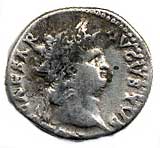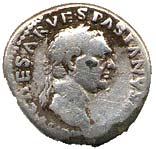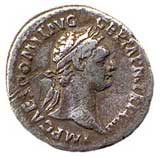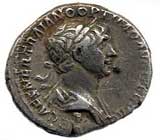
|
Image
details:
viii K Iulias, the 8th Kalends of July, i.e.
June 24th
Image ownership:
© CSAD |
The modern calendar is still fundamentally the Roman calendar,
in the form in which it was reformed by Julius Caesar. He established
the 365 day year as the basis for the calendar at Rome, with an
added 'intercalary'day (an extra day to compensate for the discrepancy
with the solar year) every four years. His 'Julian' calendar was
reformed by Pope Gregory in 1582 (the name for the modern calendar
is therefore the Gregorian calendar ). Pope Gregory removed a small
number of 'intercalary' days (three every 400 years, hence 1600
and 2000 are leap years, but not 1700, 1800 and 1900) to adjust
for the very slight deviation from the solar year in Caesar's system.
Other calendrical systems also operated in the Roman empire. Most
evidence of these alternative systems survives in the eastern Roman
empire, but a fragmentary calendar on bronze was found at Coligny
in Gaul. This is based on the lunar, not the solar year.
Years
The year was generally known by the names of the consuls who took
up office on the first of January. References to the new consuls
occur in only a very small number of Vindolanda tablets. For example,
an account (186) that records the sale
or distribution of miscellaneous items over several days spans the
transition to the New Year, and records the new consuls (abbreviated
to cos), Calpurnius Piso and Vettius Bolanus. We know from
other sources that these are the consuls for the year AD 111. Only
in exceptional circumstances can tablets otherwise be dated to a
precise year.
Months
The year was divided into twelve months, the lengths of which were
the same as they are now. To express individual days, the months
were divided into units with reference to the Kalends (Kalendae),
the first day of the month, (abbreviated to K or Kal),
Nones (Nonae), the fifth or seventh day of every month
(abbreviated to Non) and the Ides (Idus) (thirteenth
or fifteenth day). The variation in the Nones and Ides is a relic
from the pre-'Julian calendar', the later dates falling in the four
months that had originally contained 31 days.
The dates of individual days were derived from counting back, inclusively,
from the Kalends, Nones or Ides. Several accounts from Vindolanda
bear entries for a named sequence of days. 190
for example lists barley, beer and wine consumed over seven days
from the 13th Kalends of July to the 7th Kalends of July, in other
words from 19th to 25th June. The day before the Kalends, Nones
or Ides, is not expressed as the 'second Kalends etc', but as 'the
second day before the Kalends', or pridie (abbreviated to
pr) Kalendas, Nonas or Idus. In Latin
the days before the Kalends, Nones or Ides are expressed in the
accusative plural, viii K(alendas) Martias. The
days of the Kalends, Nones or Ides themselves are expressed in the
ablative. Individual days could also be identified by the feasts
which fell on them. There are occasional references to feast days
in the Vindolanda tablets, including the Saturnalia (301),
and New Year's Day, the Dies Kalendarum (265).
The following table records the days on which the Kalends, Nones
and Ides fall in each month. A (not very memorable) rhyme for remembering
the days on which they fall runs as follows.
'In March July October May
the Nones fall on the 7th day…'
| Month |
Latin name |
Day of the Kalends
|
Day of the Nones
|
Day of the Ides
|
| January |
Ianuarius |
1 |
5 |
13 |
| February |
Februarius |
1 |
5 |
13 |
| March |
Martius |
1 |
7 |
15 |
| April
|
Aprilis
|
1 |
5 |
13 |
| May |
Maius |
1 |
7 |
15 |
| June |
Iunius |
1 |
5 |
13 |
| July |
Iulius |
1 |
7 |
15 |
| August |
Augustus |
1 |
5 |
13 |
| September |
September |
1 |
5 |
13 |
| October |
October |
1 |
7 |
15 |
| November |
November |
1 |
5 |
13 |
| December |
December |
1 |
5 |
13 |
|
Events - Vindolanda, Britain and Rome -
first and second centuries AD
The table presents a timeline relating imperial reigns, events
in Britain and phases of construction at Vindolanda. The busts of
the emperors are all on silver denarii.
When they describe dates, archaeologists may refer to the century,
for example second half of the first century AD or the reign of
an individual emperor or an imperial dynasty, for example the Julio-Claudian
(from Augustus to Nero) or Flavian (Vespasian to Domitian) houses.
| Emperor |
Britain |
Vindolanda |
| AD 41
- 54 Claudius |
AD
43 Claudius invades Britain
AD 43-60 Campaign and conquest in south-west England,
Wales and Midlands
AD 60 Boudicca rebels
AD 61 Pacification of revolt in southern England
|
|
AD 54-
68 Nero

Obverse of denarius of Nero, with head of emperor (coin)
Image ownership:
Portable Antiquities Scheme
|
|
| AD 68
- 70 Galba, Otho, Vitellius |
AD
69 - 71 Campaigns vs Brigantes northern England
AD 77/78 Agricola campaigns in Wales and northern Britain
AD 78/79 - 83/84 Agricola campaigns in Scotland, defeats
Caledonians at Mons Graupius
AD 84 - Agricola recalled
AD 84 - c. AD 100 Retreat from Scotland and establishment
of 'Stanegate' frontier
|
|
AD
70 - 79 Vespasian

Obverse of denarius of Vespasian, with head of emperor (coin)
Image ownership:
Portable Antiquities Scheme
|
|
| AD
79-81 Titus |
|
AD 81-96
Domitian

Obverse of denarius of Domitian, with head of emperor (coin)
Image ownership:
Portable Antiquities Scheme
|
(Early
fort?)
c. AD 85 -92 Period 1
c. AD 92-97 Period 2
c. AD 97-105 Period 3
c. AD 105-120 Period 4
c. AD 120 - mid second century Period 5
|
AD 96-98
Nerva
|
AD 98-117
Trajan

Obverse of denarius of Trajan, with bust of emperor (coin)
Image ownership:
Portable Antiquities Scheme
|
Wars
in Britain? |
AD 117-
138 Hadrian

Obverse of denarius of Hadrian, with bust of emperor (coin)
Image ownership:
Portable Antiquities Scheme
|
AD 122
Construction of Hadrian's Wall begins |
| AD 138-161
Antoninius Pius |
AD 142
Antonine Wall constructed |
c. Mid
second century Period 6 |
|
For further information see the History
of Vindolanda section of the exhibition.
|